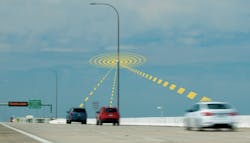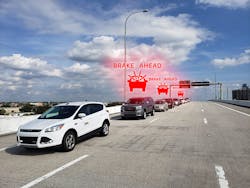Tampa CV Pilot testing paves the way for creating smarter, safer cities
In the quest for transportation safety innovation, the Tampa Hillsborough Expressway Authority’s (THEA) Phase 4 of the Connected Vehicle (CV) Pilot is taking center stage.
THEA has worked with the U.S. Department of Transportation (U.S. DOT) for more than six years as a CV Pilot site. This current phase has led to particularly exciting collaborations with auto manufacturers; novel ideas leading to patents for real-time roadway debris, accident detection and proactive congestion detection algorithms; and testing of new communication technology.
THEA partnered with the top tier in research and academics as well as automobile grade original equipment manufacturers (OEM) for software and firmware research and development, particularly with V2V applications. Initial partnering meetings began in Tampa in November 2020, followed by touchpoints in Michigan in March 2021 to test integration and interoperability, and then participant recruitment and testing in the summer of 2021. The initial findings today show how a national picture can be composed with larger agency adoption and how this phase has proved beneficial towards the next evolution of delivering safer transportation solutions. These collaborations led to safety and mobility applications that actual drivers in the downtown Tampa business district are currently testing through the end of this phase.
During the CV Pilot, Tampa Bay’s population, tourism, and economic development vastly increased. The city is transforming with new urban environments, transportation offerings, and a heightened focus on Vision Zero implementation to eliminate traffic fatalities and severe injuries. Phase 4 lessons learned for the transportation sector regarding connected technology are more important and pertinent as this technology can truly assist in transforming grid systems throughout the U.S. into smart cities. Ultimately, Phase 4 demonstrates the tremendous value that working with OEMs such as Honda Research Institute USA Inc., Hyundai Kia America Technical Center Inc., Toyota Motor North America – R&D, and Denso International America Inc. brings to vehicle-to-infrastructure (V2I) and vehicle-to-vehicle (V2V) deployments.
With the CV Pilot, as with any testing and research, partner collaborations became key to working through challenges. The team faced the challenge of recruiting drivers during a pandemic with public outreach starting in June 2021 and then carrying on to the holiday season. In addition, there was some driver resistance to altering newly purchased vehicles with the mounted head-up display/OBU or the two antennae mountings and short-range trunk radio that were necessary for the additional safety features.
“Participants were enthusiastic about being a part of this research study, getting to use a top-tier CV device, and being part of a solution that will make getting around safer and easier,” said HNTB Associate Fellow Steve Novosad. “While especially the researchers evaluating the pilot would always like to have more participants to test the applications’ max performance capabilities, the data being collected currently will help us understand real-world road conditions. CV technology can be a game-changing improvement as cities level up their commitment to performance-based planning and implementation to vastly change our landscape for the better.”
“We are here to help create the system of the future with smart, innovative choices that can help our region succeed as it grows,” said THEA Executive Director/CEO Greg Slater, who took the helm at THEA in early February 2022. His predecessor, technology pioneer and THEA former Executive Director/CEO Joe Waggoner received multiple accolades for how he led THEA to innovate and share best practices from Tampa Bay with agencies throughout the world.
As University of South Florida’s Center for Urban Transportation Research (CUTR) Associate Professor Dr. Sisinnio Concas has noted during this phase, with the growth of the downtown business district and THEA’s infrastructure, the data collected will show key insights on everything from facility usage to how the population organizes its travel and even realities of the pandemic, such as an increased amount of car accidents. These findings can potentially lead to the implementation of further OBU safety alert enhancements that drivers can receive in real-time.
“From data crunching at the research level to measuring substantial economic benefits, CUTR and THEA are sensitive to the environment and refinement of analyses to create actionable plans that truly make a difference in the community,” said Dr. Sisinnio Concas.
Even the impact of the CV human machine interface (HMI), including the head-up display and audible alerts, on traveler behavior is being examined as both OEMs and researchers found vast discoveries during this phase of the CV Pilot. For OEMs, the lessons learned pertain to signalization information, HMI and scaling this technology to national acceptance and implementation in deeper, broader ways. For example, the countdown time for traffic signals is contingent on whether testing involves an emphasis on red or green signal times. With red light violation warnings and countdown timers on the OBUs, testing models demonstrated how there are jurisdictional differences that are a must to account for when scaling this nationwide. Further, the OEM industry looks at these factors differently than traffic engineer experts and this is where collaboration between the private sector and governmental agencies help to further thought leadership, research, and the sustainability of transportation systems. Spending more time in the deployment phase under real-world conditions is crucial for this proof of concept to scale to mass adoption.
“Collaboration with top companies that are known for safe products that can be scaled efficiently provides a model and path for how to more efficiently and effectively create a better overall suite of safety applications for drivers of today and the future,” said THEA’s Director of Planning and Innovation Robert Frey. “Add in the lessons learned from the other two U.S. DOT pilots—WyDOT and NYCDOT—and the state/local pilots show how bigger agencies can complement innovation leaders like THEA to bring this to even larger cities and regions to greatly increase the quality of life.”
In the region, for example, the Florida Department of Transportation (FDOT) I-4 Florida Regional Advanced Mobility Elements (FRAME)—a regional/intercity integrated corridor management (ICM) project—is one of those initiatives that complements the broader context of the CV Pilots’ purpose and ultimately the end results. For automated, connected, electric, and shared (ACES) mobility to become more mainstream in the near future—especially with the exponential rate of technological advancement and planning horizons narrowed to shorter windows to capitalize on current best practices—top-tier OEMs are key allies to work with broader enhancements needed to optimize radio spectrum advancements and beyond.
“I cannot emphasize how important the OEMs are to making these innovations happen at scale,” said Frey. “I look to the current move to electric vehicles (EV) over the last several years where we went from one or two EV choices to a wide selection in a short time. If you want an EV, you can buy one. This shows that the OEMs are the implementation piece of the equation that needs to be in place. I can envision a day when connectivity has the momentum that electric has to make the roads safer as well as greener.”
By spring of this year, OBU reports that can begin to be analyzed will be produced by THEA CV Pilot researchers to validate how these applications make a difference in delivering safety benefits to drivers, the public, and the community. Through a systems engineering process, the team’s operational lessons have helped numerous other agencies since the pilot inception in 2015 as well as created opportunities with other agencies around the U.S. and world to further ACES initiatives.
“These pilots have shown how CV does in fact increase safety,” said Novosad. “Collaboration with a big DOT can take these emerging mobility technologies to the next level. Whether you are wondering where the last vehicle in my horizon is so you brake appropriately or think about how your grandkids will use these technologies to improve their quality of life, AV and CV technology is the lifesaver we all deserve.”
From the region to the nation, we are in an exciting time for ACES and the evolution of transit. THEA is looking to the near-term horizon for even more safety, mobility, and environmental benefits through autonomous and connected vehicle technology. Open discussions with other cutting-edge DOTs as well as longtime collaborators for testing, deploying, and innovating for the greater good are all part of upcoming efforts. The acceleration of Vision Zero implementations and initiatives such as the CV Pilot are models for others in the transportation industry to step outside their industry zone to reap far more benefits for safety and mobility.


